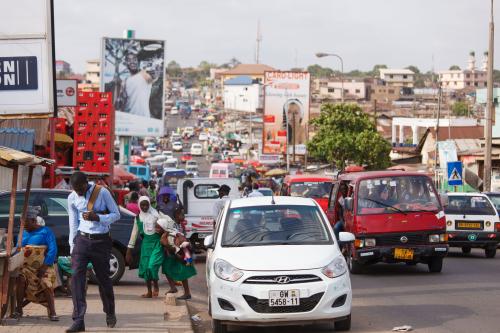Below is a viewpoint from the Foresight Africa 2023 report, which explores top priorities for the region in the coming year. Read the full chapter on Africa’s cities.
 Between 2015 and 2018, Cape Town endured a one-in-400 year drought which took the city of around 4.6 million residents to the brink of “day zero,” a point when Cape Town would run out of water.
Between 2015 and 2018, Cape Town endured a one-in-400 year drought which took the city of around 4.6 million residents to the brink of “day zero,” a point when Cape Town would run out of water.
What ultimately saved the day, was a combination of sustained public communications and innovative engineering solutions.
Cape Town’s communications of the drought were successful due to the city administration’s ability to accurately measure its daily drinking water production, as well as its dam levels. This enabled the city to set a target water usage for each resident per day, so that the reservoirs in the dams could last until the winter rainfall season.
Daily public communication stressed the need for residents to, inter alia, take short showers, flush only when necessary, and refrain from using drinking water for gardening. Campaigns also targeted visitors to the city, under the slogan “save (water) like a local.” The city communicated a moving forecast of whether “day zero” was being pushed out as a result of successful water saving measures.
In addition to raising awareness, the city also looked to increase distribution efficiency and curb water losses. Recent studies have shown that pressure management in urban water distribution networks is one of the cost-effective ways to extend asset-life and reduce water leakages, which can sometimes account for up to 70 percent of total water losses. Cape Town is fortunate to be a leading metro for pressure management technology, establishing 170 pressure management zones covering 68 percent of the water network as of June 2021. This upped the city’s ability to reduce leaks, bursts, and especially consumption, with savings of 70 million liters per day (ML/d) at the peak of the 2018 drought.
As an incoming mayor post the drought crisis, my priority is to ensure that Cape Town’s New Water Programme (NWP) delivers around 300 million liters (Ml) per day by 2030 from new alternative water sources.
As an incoming mayor post the drought crisis, my priority is to ensure that Cape Town’s New Water Programme (NWP) delivers around 300 million liters (Ml) per day by 2030 from new alternative water sources.
To achieve this, one of my first actions was to quadruple the city’s annual rate for water and sewer pipe replacement so that our supply network remains in good order, and water losses remain low.
Over the next three years, around R10 billion of the city’s R30 billion capital expenditure plan will also be invested in water and sanitation infrastructure to ensure sustainable development.
The city has further raised R1 billion through a Green Bond listed on the Johannesburg Stock Exchange (JSE), helping to fund key sustainability infrastructure projects, including upgrades to reservoirs, water pressure management, water re-use, and upgrades to sewer and water supply networks.
We are planning to invest about R4.7 billion to bring about 105 million liters of groundwater a day into our drinking supply by 2036. The Table Mountain Group Aquifer has already delivered its first water in 2020, and the first groundwater to be injected into the supply network from the Cape Flats Aquifer is expected towards the middle of 2023.
Water efficiency will be further enhanced through state-of-the-art, automated domestic water metering installations rolled out progressively over the next decade, as well as a robust alien vegetation (exotic, non-indigenous vegetation which tends to guzzle water supply from rivers and dams, crowding out indigenous vegetation) clearing program along waterways.
Regarding water reuse and desalination projects, the city has set up an Independent Advisory Panel and partnered with the South African Water Research Commission (WRC) to coordinate and provide research, development, transparency, and accountability.
Cape Town is proving that we have learned the right lessons from the drought crisis by converting water savings into a culture, with a proactive bid to use less than 950 million liters daily this summer. This will enable us to avoid low-level water restrictions next summer if we experience another below average winter rainfall.







Commentary
Cape Town: Lessons from managing water scarcity
March 22, 2023